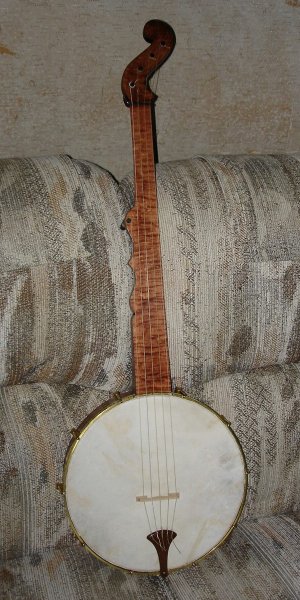
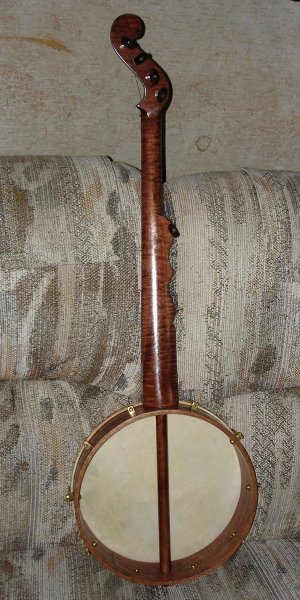
It is now the end of June, 2006 and my new minstrel banjo is finished enough to be tuned up and played.
Before I review this kit, I want to say that this is an absolutely gorgeous banjo. The dark, curly wood next to the bright brass is just wonderful. I would also like to mention that Bob Flesher is a joy to do business with. He is responsive and ready to do whatever is necessary to make his customers have a successful outcome. That said, here are some photos of the instrument in its current form:

|

|
Here are some closeups of the various parts. The neck has some very nice curl in it:
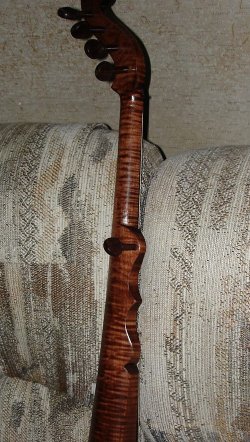
|
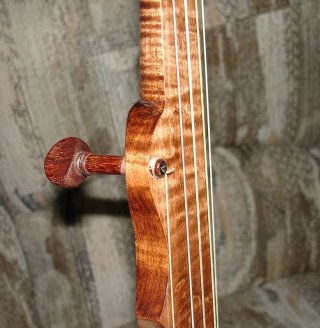
|
Here is the peghead, front and back.
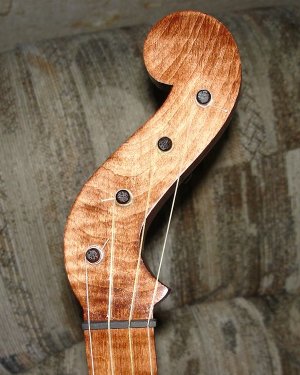
|
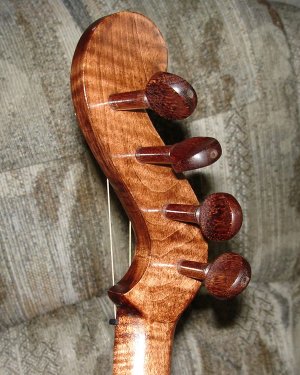
|
And finally, a closeup of the pot assembly.
The strings have had some time to stretch out now, and the banjo seems to be quite playable. We are suffering through a very wet Spring here in New England, so the pegs are stuck in their holes and the head is a bit mushy. But those things should improve as the weather clears up. We shall see.
The banjo has a very deep voice since it has a 12 inch pot, and it is tuned down to the key of D. For the "standard", or "Low Bass" tuning, the strings are tuned to:
This is equivalent to a Drop-C tuning on a modern banjo, but it is tuned down a fourth.
I have found that it is easier to play the fretless than I had imagined. My fingers remember where to go from years of playing fretted banjos. If you have learned how to fret properly (i.e. placing your fingers just behind the frets) that will get you into the ballpark for the fretless. Playing better in tune will just take practice for the fingers and the ears.
As far as the quality of the kit goes, there were few problems. Other than that pesky tension hoop that was always coming apart, the banjo went together quite smoothly. Up to that point it was a pretty easy kit to build. The directions were OK. They are adequate as long as you aren't totally in the dark about how a banjo gets built. I do wish that someone would update the head stretching instructions. It seems that everybody just passes on those old words and woodcuts from the S. S. Stewart catalog published in 1887. C'mon, guys, can't somebody come up with some more modern instructions?
Here are some tips should you decide to do this kit, I would suggest finding or making some long, steel hooks for mounting the head. That tension hoop might have held (although I doubt it) if I had been able to ease it down over the rim gradually with hooks instead of having to push it all the way down at once. But to be fair to me, no mention was made in the kit instructions about using long hooks to start out. I was impossible to follow the S. S. Stewart instructions with the short hooks that were in the kit. The long hooks are mentioned in the original S. S. Stewart instructions.
Go ahead and use all of the flatware that you have the first time you attempt to stretch the head just to get some good mojo going :-)
I have been keeping track of the time spent on each step of the construction. I added it up, and I spent about 30 hours building this banjo. That includes just the time actually working on it, not the time running around and thinking about it, waiting for stuff to dry, etc. I started building the banjo back in December 2005 when I recieved it, and it is now near the end of June, 2006. So in calendar time I spent just over six months at it. But most of that time was spent waiting for the weather to clear since my "shop" is in my unheated garage.
The question that I must ask is, "Was it worth it?" The answer to that depends on what you want to do. If you decide to build a kit like this to save some money, then think again. Bob charges $1250 (2006 dollars) for a ready-made banjo that is a bit fancier (and probably put together better than mine). If I paid myself what my auto mechanic gets ($75 per hour) I would have to pay myself $2250 plus the $500 that I paid for the kit, bringing the total up to $2750. So, from a financial standpoint, this is a bust. Don't do it for that reason.
On the other hand, I had never stretched a skin head before (now I have done it 4 times!). I also learned a lot of other things along way, such as things about brazing and staining and working metal. So if the goal was to learn how one of these things goes together, I just bought myself a course in banjo construction for $500 and 30 hours of weekends... and I get to keep a gorgeous banjo in the bargain. Not a bad deal.
There are still some setup issues to come, such as keeping the head tight as the weather changes and learning how to use the tuning pegs. It will take some time for the new wood to stabilize in its new home. I will post any new information as it becomes available.